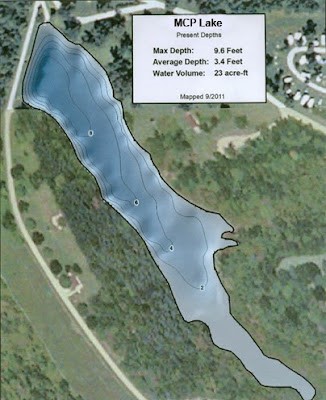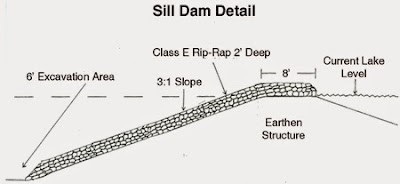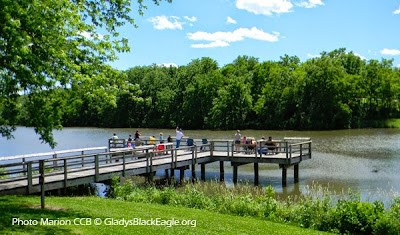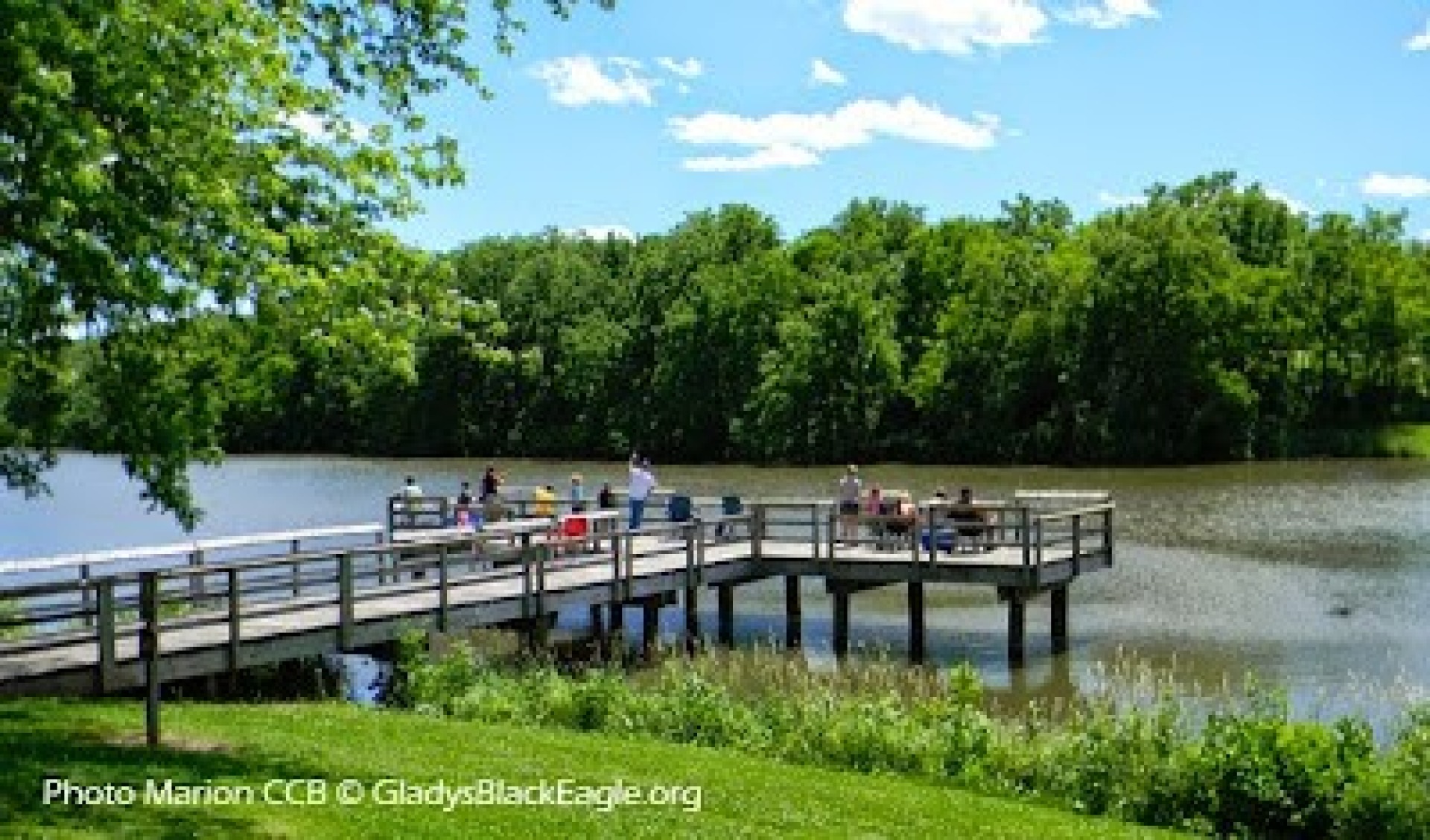2015 Lake Renovation at Marion County Park!
Marla Mertz, Marion County Naturalist
Background

Marion County Park (MCP) is located on the west edge of Knoxville, Iowa, and is managed by the Marion County Conservation Board (MCCB). The 140-acre park of gently rolling hills offers a wide variety of recreational opportunities to the outdoor enthusiast. A large campground with 99 electrical sites, modern shower / restroom facilities, drinking water, and picnic shelters offers a great summer retreat for the whole family. Picnic areas with playground equipment are located nearby and for the kids who want to practice “America’s Favorite Pastime,” four baseball / softball fields are located in the southern section of the park. A basketball court and horseshoe courts are also available.
The Marion County Historical Society operates a historical village at the park, complete with log cabin, museum, country schoolhouse and church, general store, stagecoach stop, and working windmill. The buildings are open on weekends from Memorial Day through Labor Day, 1:00-5:00 p.m. or by appointment.
The Marion County Park Lake was constructed in 1961 at a cost of $11,038 and was originally 7.91 acres in size. The original maximum depth was 24 feet and lake-depth averaged 14 feet. The lake contained largemouth bass, bluegills, crappie, and channel catfish. An all-accessible fishing pier was constructed in 1992. A concrete boat ramp and dock was also available for the public. 100,000 channel catfish had been raised and released through a caged-rearing program since 1985.
This county area is one of Marion County Conservation Board’s highlighted campgrounds and the seven acre lake has been the main focal point of the park as a relaxing place to visit and a ‘sure to please’ fishing and wildlife viewing area.
Over the past several years, a significant portion of the lake’s water volume had been lost to sedimentation. Fish and aquatic life had also deteriorated due to sediment, turbidity and poor water quality. The shallowness of the lake allowed wave action to erode lakeshore sediments and nutrients causing poor water clarity and algae blooms, which are also detrimental to fish growth. A shallow lake with algae blooms are more prone to summer and winter fish kills because of low dissolved oxygen levels.
Knoxville Middle School students and many others have visited the lake area at MCP. Students gain exposure to a wetland ecosystem and study the macro-invertebrates, oxygen levels, aspects of sedimentation, and algal blooms. The students helped document the abundance of macro-invertebrates and changes over past several years.
Learn more about the importance of mussels.
- 10 Cool facts: Freshwater Mussels of Iowa
- Cedar River Watershed Project: Cedar River Aquatic Life
- Missouri's Freshwater Mussels
Planning for the pond improvements began in 2011. Iowa Department of Natural Resources Fisheries staff mapped pond depths and sampled fish to have initial fishery data.
2011 Iowa DNR Fishery Summary of MCP Lake
The lake was sampled in 2011 to get initial fishery data before efforts begin to improve the pond. Bluegill and largemouth bass were collected using an electrofishing boat that temporarily stuns the fish so that they can be netted and brought into the boat for measurements. Channel catfish were collected using hoop nets baited with soybean cake left in the water to fish for 72 hours.
Bluegills from 3 to 6.5 inches were very abundant. Angler preferred size for bluegills is greater than 7 inches. The bluegills in this pond would be considered stunted, or not reaching their growth potential. Largemouth bass are also present in good numbers and condition from 5 to 15 inches with most fish being between 8 and 11 inches. This is considered a fair population for a pond this size. Channel catfish are present in over-abundance and could use some angler harvest. There are high numbers of catfish between 10 and 16 inches and smaller numbers spread out up to 27 inches.
Common carp are also present. Common carp are undesirable due to their ability to remove all submerged aquatic vegetation. The absence of aquatic vegetation reduces the number and diversity of macro-invertebrates. This reduced number of macro-invertebrates is likely the primary cause of the poor bluegill growth. No additional fish species were observed. The only species we would like to see in the pond are bluegill, largemouth bass, and channel catfish.
In addition to sampling the fish population, the current lake depths and sediment depths were mapped to assist the county in obtaining grant money to remove sediment from the lake. A significant portion of the initial water volume has been lost to sedimentation from the watershed. The shallowness allows wave action to re-suspend the sediment and nutrients causing poor water clarity and algae blooms, which is detrimental to fish growth, especially bluegills. Ponds and lakes with high turbidity or frequent algae blooms rarely contain fish populations with good size structure and are dominated by small or stunted fish. Shallow ponds or lakes with algae blooms are also more prone to summer and winter fish kills. This is due to low dissolved oxygen levels occurring during night time, calm, cloudy days, and heavy ice and snow cover when algae and decaying matter use all of the dissolved oxygen in the smaller water volume as compared to a deep pond or lake. Low dissolved oxygen fish kills have occurred in the Marion County Conservation Lake in the past. The planned renovations including sediment removal should improve water quality, re-establish aquatic vegetation, improve fish growth, and reduce or eliminate the risk of fish kills due to low dissolved oxygen.

The map shows the lake depths from September 2011. The maximum water depth recorded was 9.6 feet and the average depth a dismal 3.4 feet deep. Corrective action needed to be done soon.
Renovation
In order to restore water quality, improve aquatic wildlife habitat, and improve the fishery, a four-phase project was designed to reduce the amount of sediment and nutrients reaching the pond.
The Purpose of this project:
- Remove over 50 years of sediment.
- Restore lake quality close to the levels at its creation.
- Improve fish and aquatic wildlife habitat.
- Reduce silt and sediment from reaching the lake by constructing a sill dam and silt retention basin upstream.
- Improve recreational use of a popular area.
Project bids:
- Sill dam and silt retention basin, removal of 7,000 cubic yards of sediment - $76,000
- Lake dredging, removal of 65,000 cubic yards sediment - $343,000
- Total project bids - $419,000
Funding available for the project:
- DNR Fish Habitat Grant Program - $150,000
- MCCB Conservation Reserve Account - $200,000
- Local Option Sales Tax (LOST) - $285,000
- Total funding available - $635,000
Phase 1: Build sill retention dam and retention pond
- In the fall of 2013, Stek Earthmoving was contracted to build a silt retention basin and 175' long sill dam. A sill dam acts as a barrier that slows down the incoming water and allows the sediments to be deposited in the silt retention basin which reduces silt and sediment from reaching the lake.
- 7,000 cubic yards of sedimentation material equaling 700 tandem dump truck loads were removed.

Phase 2: Working with landowners upstream addressing sediment issues.
Phase 3: Drain and dredge main lake
- Reilly Construction was contracted to dredge and work began November 19, 2014, but had to stop work during an usual winter warm-up, and work was completed on March 16, 2015. Over 82,000 cubic yards of soil and silt were removed, which is approximately 4,555 quarry dumptruck loads.
- A second silt retention basin and sill dam were constructed, as well as a 12'x60' rock fishing jetty.
- The maximum depth at completion was 25' with an average depth of 20'.
Phase 4: Install fish habitat and restock fish
- MCCB staff installed and constructed various fish habitat structures including sinking recycled Christmas tree reef structures, developing shallows for spawning areas, building rock islands and catfish hotels, and placing wooden structures necessary for a good fishery.
- The Iowa Department of Natural Resources will assist the MCCB in stocking the MCP Lake. Bass and bluegill were stocked in April 2015. Channel catfish are to stocked in the fall 2015.
Final Cost Summary of Marion County Park Lake Renovation
Available funds - $635,000
Total project cost - $522,003
- Sill retention dam and and retention pond - $76,000
- Dredging of lake (including additional depth work), including mobilization, clearing and grubbing, dredging of waste material, drain pipe replacement, and sill dam construction - $415,697
- Fishing jetty - $18,091
- Silt Basin - $12,215
Hopefully, it won't be long before we can bring out the fishing poles, but until then, come and see us, stay with us, picnic with us, and enjoy this beautiful park! Many of you have followed this project with us, and thank you for your patience!
Check out these photos of Marion County Park Lake before and during the lake renovation! The lake was full by early May 2015.

Follow-up
Iowa Department of Natural Resources fisheries staff conducted another fish survey (using electro-shock to temporarily stun the fish so they float to the surface for easy netting - this is the method used and shows no long term affects to fish) and water quality survey in June 2016. Staff were checking on status of stocked fish and the 2016 spawn. Secchi disk test showed water clarity to 11 feet! Fisheries staff also commented that the fish were colorful and healthy which reflects back to the lake's water quality. The largemouth bass that were stocked April 2015 appeared to have a successful spawn evidenced by the number of small bass seen. The bluegill stocked April 2015 showed good growth with one measuring 6.5 inches. Most catfish that were in the lake were in cooler, deeper water than fisheries staff were shocking, but they did see some small catfish to know that they survived and were doing well.
Learn more about sedimentation and water quality here:
- Where does water go after it goes down the drain?
- Red Rock's Dirty Secret
- The Mud Stops Here (video)
published Wednesday, April 1, 2020



